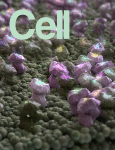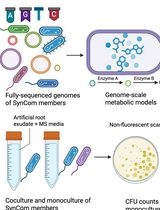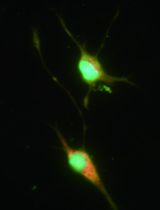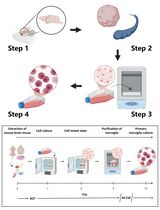- EN - English
- CN - 中文
Platelet Migration and Bacterial Trapping Assay under Flow
流动条件下血小板迁移和细菌捕获检测
发布: 2018年09月20日第8卷第18期 DOI: 10.21769/BioProtoc.3018 浏览次数: 6861
评审: Andrea PuharSuprabhat MukherjeeLip Nam LOH
Abstract
Blood platelets are critical for hemostasis and thrombosis, but also play diverse roles during immune responses. We have recently reported that platelets migrate at sites of infection in vitro and in vivo. Importantly, platelets use their ability to migrate to collect and bundle fibrin (ogen)-bound bacteria accomplishing efficient intravascular bacterial trapping. Here, we describe a method that allows analyzing platelet migration in vitro, focusing on their ability to collect bacteria and trap bacteria under flow.
Keywords: Platelets (血小板)Background
Platelets are small, anucleate cellular fragments released from megakaryocytes that reside within the bone marrow of mammalian organisms (Machlus and Italiano, 2013). Approximately 750 billion platelets circulate in human blood, constantly scanning the vasculature for damage of the endothelial surface. Upon encountering endothelial injury, platelets are immediately recruited in a well-characterized cascade of events including initial platelet tethering and rolling, followed by platelet activation, adhesion and spreading, eventually leading to fibrin (ogen)-dependent aggregation and subsequent thrombus retraction (Jackson, 2007). Platelet plug formation is a major step in physiological hemostasis, but also in pathological thrombosis after atherosclerotic plaque rupture, triggering myocardial infarction or stroke (Jackson, 2011).
In addition to their well-established role in hemostasis and thrombosis, platelets also evolved diverse immunologic functions (Semple et al., 2011). Being among the first cells recruited to sites of inflammation and infection, platelets play an essential role in initiating intravascular immune responses (Wong et al., 2013). Accordingly, platelets coordinate the recruitment of a variety of immune cells and instruct them with their effector programs (Sreeramkumar et al., 2014). Platelets also have the ability to directly fight pathogens by releasing anti-microbial mediators and/or physically trapping and encapsulating invaders, thus preventing dissemination with the blood flow (Yeaman, 2014).
We recently identified platelet migration as an autonomous platelet function and showed that migration of single platelets provides a mechanism of controlling their interaction with pathogenic bacteria within the microcirculation (Gaertner et al., 2017). Once adhering to immobilized fibrin (ogen), activated platelets use αIIbβ3 integrins to probe the resistance of their local microenvironment. When actomyosin-dependent traction forces overcome substrate resistance platelets eventually polarize and migrate thereby removing and accumulating platelet-bound ligands. As a prominent example, migrating platelets collect and bundle fibrin (ogen)-bound bacteria accomplishing efficient intravascular bacterial trapping. In contrast to phagocytes like neutrophils, platelets behave like “covercytes” that do not internalize collected bacteria but rather accumulate them on their surface within invaginations of the plasma membrane (White, 2005). When exposed to shear stress in vitro platelets strongly bind to piled-up bacteria.
Here we provide a detailed protocol for the isolation of platelets from human blood and microscopic observation of platelet migration and trapping of Escherichia coli (E. coli) under flow.
Materials and Reagents
- Pipette tips 0.1-10 μl (Eppendorf, epT.I.P.S.® Reloads, catalog number: 022491504 )
- Pipette tips 0.5-20 μl (Eppendorf, epT.I.P.S.® Reloads, catalog number: 022491521 )
- Pipette tips 2-200 μl (Eppendorf, epT.I.P.S.® Reloads, catalog number: 022491539 )
- Pipette tips 50-1,000 μl (Eppendorf, epT.I.P.S.® Reloads, catalog number: 022491555 )
- 15 ml Falcon tube (Corning, catalog number: 352096 )
- Tygon 3350 silicone tube (Saint-Gobain Performance Plastics, catalog number: ABW00002 )
- Safety-Multifly-Needle 21G (SARSTEDT, catalog number: 85.1638.935 )
- Membrane adaptor (SARSTEDT, catalog number: 14.1112 )
- 5 ml syringes (BD, Discardit IITM, catalog number: 301285 )
- 50 ml syringes (BD, perfusion, catalog number: 300136 )
- Bottomless 6 channel sticky slide (IBIDI, sticky slides VI0.4, catalog number: 80608 )
- Glass coverslips 24 mm x 24 mm (SCHOTT, NEXTERION®, No. 1.5, catalog number: D263T )
- Cuvette (Eppendorf, catalog number: 952010069 )
- Human blood (taken from male and female healthy donors with the age of 25-40 years old)
- Plasmid ptdTomato (Takara Bio, catalog number: 632531 )
- E. coli strains (DH12S, Invitrogen)
E. coli was transformed with plasmid ptdTomato. TdTomato is encoded within the lac operon and transcription is induced in the presence of isopropylthio-β-galactoside (IPTG) (IPTG binds to the lac repressor and releases lac repressor from the lac operator). The plasmid carries the bla-gene for ampicillin resistance.
Note: E. coli stock was made in LB with 7% dimethyl sulfoxide (v/v) and kept at -80 °C. - Distilled water (ddH2O) (Millipore)
- Dimethyl sulfoxide (DMSO) (Sigma-Aldrich, catalog number: D2438 )
- Phosphate buffered saline (PBS) (Sigma-Aldrich, catalog number: D8537 )
- Recombinant human albumin (rHSA) (Sigma-Aldrich, catalog number: A9731 )
Note: Dissolve rHSA in ddH2O to 8% (w/v) solution and store the aliquots at -20 °C. - Prostaglandin I2 sodium salt (PGI2) (Abcam, catalog number: ab120912 )
Note: Dissolve it in DMSO to 10 mg/ml and store the aliquots at -20 °C. - HEPES solution (Sigma-Aldrich, catalog number: H0887 )
- 20% HNO3 (Carl Roth, catalog number: 4337.2 )
- Hexamethyldisilazane (HMDS) (Sigma-Aldrich, catalog number: 440191 )
- Fibrinogen from human plasma (Sigma-Aldrich, catalog number: F3879 )
Note: Dissolve it in 0.9% NaCl to 2 mg/ml and store the aliquots at -20 °C. - Fibrinogen from human plasma, Alexa Fluor 488 conjugate (Thermo Fisher Scientific, Life technology, catalog number: F13191 )
Note: Dissolve it in 0.1 M NaHCO3 (pH 8.3) to 1.5 mg/ml and store the aliquots at -20 °C. - U46619 (Enzo Life Sciences, catalog number: BML-PG023-0001 )
Note: Dissolve it in DMSO to 28.8 mM and store the aliquots at -20 °C. - Adenosine 5′-diphosphate sodium salt (ADP) (Sigma-Aldrich, catalog number: A2754 )
Note: Dissolve it in PBS to 20 mM and store the aliquots at -20 °C. - Thrombin from bovine plasma (Sigma-Aldrich, catalog number: T4648 )
Note: Dissolve it in 0.1% (w/v) bovine serum albumin (BSA) to 100 U/ml and store the aliquots at -20 °C. - LB broth (Sigma-Aldrich, catalog number: L3022 )
Note: 20 g LB powder was dissolved in 1 L ddH2O and autoclaved. - Isopropyl β-D-1-thiogalactopyranoside (IPTG) (Sigma-Aldrich, catalog number: I6758 )
Note: Dissolve IPTG in ddH2O to 100 mM and store the aliquots at -20 °C. - Ampicillin sodium salt (Sigma-Aldrich, catalog number: A9518 )
Note: Dissolve ampicillin in ddH2O to 50 mg/ml and store the aliquots at -20 °C. - Sodium citrate tribasic dehydrate (C6H5Na3O7•2H2O) (Sigma-Aldrich, catalog number: S4641 )
- Citric acid monohydrate(C6H8O7•H2O) (Sigma-Aldrich, catalog number: C1909 )
- Glucose (Merck, Calbiochem, catalog number: 346351 )
- Sodium chloride (NaCl) (Carl Roth, catalog number: 3957.3 )
- Sodium bicarbonate (NaHCO3) (Merck, catalog number: 106329 )
- Potassium chloride (KCl) (Carl Roth, catalog number: 6781.3 )
- Calcium chloride (CaCl2) (Sigma-Aldrich, catalog number: C8106 )
Note: CaCl2•2H2O was dissolved in ddH2O to make 100 mM stock solution and stored at 4 °C. - Acid-citrate-dextrose (ACD) buffer, pH 4.7 (see Recipes)
- Modified Tyrode's buffer (see Recipes)
- Fibrin buffer (see Recipes)
Equipment
- Pipette 0.1-2.5 μl (e.g., Eppendorf, Research plus: O18485E)
- Pipette 0.5-10 μl (e.g., Eppendorf, Research plus: O30964E)
- Pipette 10-100 μl (e.g., Eppendorf, Research plus: O30379E)
- Pipette 100-1,000 μl (e.g., Eppendorf, Research plus: O29260E)
- Orbi-Shaker (e.g., Benchmark)
- pH meter (e.g., Mettler Toledo)
- BioPhotometer (e.g., Eppendorf, model: BioPhotometer 6131 )
- Bunsen burner (e.g., Campingaz)
- Centrifuge (e.g., Eppendorf, model: 5804 )
- Cell culture incubator (e.g., Binder)
- Hematology counter (e.g., Horiba Medical)
- KLM spin coater (e.g., Schaefer)
- Inverted phase contrast and fluorescent microscope (e.g., OLYMPUS, model: IX83 )
- Syringe pump (e.g., KD Scientific, model: KDS 100 )
Software
- Live cell imaging software that was connected to the microscope (e.g., CellSense)
- Fiji software [National Institutes of Health (NIH)]
Procedure
文章信息
版权信息
© 2018 The Authors; exclusive licensee Bio-protocol LLC.
如何引用
Fan, S., Lorenz, M., Massberg, S. and Gaertner, F. (2018). Platelet Migration and Bacterial Trapping Assay under Flow. Bio-protocol 8(18): e3018. DOI: 10.21769/BioProtoc.3018.
分类
免疫学 > 宿主防御 > 人
微生物学 > 微生物-宿主相互作用 > 细菌
细胞生物学 > 细胞分离和培养 > 细胞分离
您对这篇实验方法有问题吗?
在此处发布您的问题,我们将邀请本文作者来回答。同时,我们会将您的问题发布到Bio-protocol Exchange,以便寻求社区成员的帮助。
Share
Bluesky
X
Copy link













